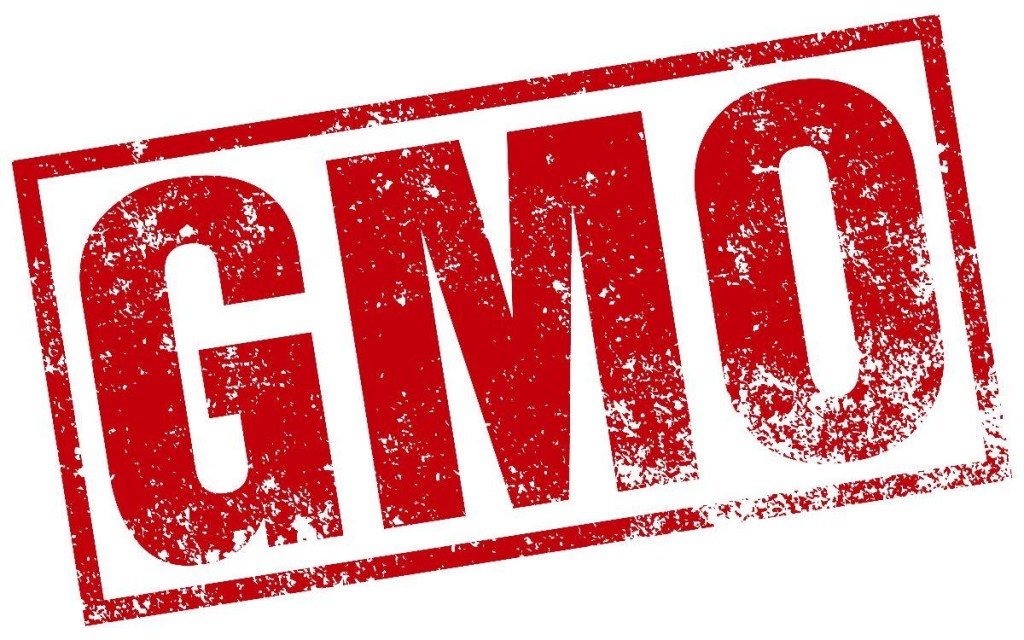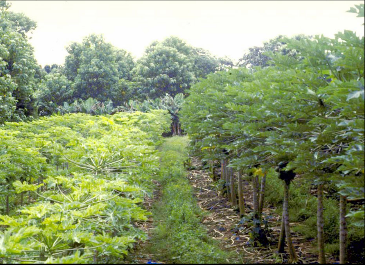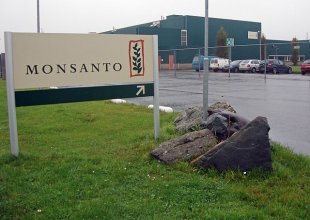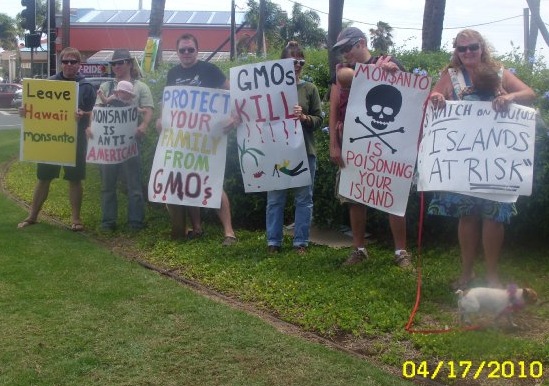More Than 100 Monsanto Employees Crashed My Presentation on GE Crops and Pesticides in Hawaii
ORGANIC, GMO, GENETIC ENGINEERING, 9 Nov 2015
Ashley Lukens, Center for Food Safety – AlterNet
 Nov 2, 2015 – On October 14, I presented the findings of the Center for Food Safety’s Pesticides in Paradise report on the island of Moloka‘i in Hawai’i. At around 5:45 PM, about 15 minutes before the presentation was going to start, more than 100 Monsanto employees, all dressed in neon yellow shirts, arrived.
Nov 2, 2015 – On October 14, I presented the findings of the Center for Food Safety’s Pesticides in Paradise report on the island of Moloka‘i in Hawai’i. At around 5:45 PM, about 15 minutes before the presentation was going to start, more than 100 Monsanto employees, all dressed in neon yellow shirts, arrived.
As I stared at the long line of workers, men and women of all colors and ages and sizes, entering the building, there was a moment when I wanted to walk away. I walked to the bathroom and sat with my face in my hands. I am not brave enough for this confrontation. I am not the right person to deliver this message. I am not strong enough for the yelling and fighting that will likely ensue. Deep breaths. Air punches.
I re-entered the main hall, now crowded with community members, workers. The island is so small that I already recognized faces from the four days I had spent here. My team gave me half horrified, half encouraging looks as I paced the front of the hall. With a few deep breaths and a nod from the few friends we had in the audience, I began. (You can watch the full video, un-edited here).
The presentation walks the audience through data on pesticides and genetically engineered crops in Hawai‘i and the medical literature that examines the human health and environmental impacts of pesticide exposure, on pregnant women, children, and farm workers, who are particularly vulnerable to adverse health effects.
And herein lies the greatest challenge of that night and the greatest opportunity. Although seemingly there to intimidate me and oppose our message, these 100+ people are the most at risk from the growing GE seed industry in our state.
Workers exposed to restricted use pesticides have higher rates of chronic diseases such as bladder and colon cancer[i] Non-Hodgkin’s lymphoma[ii],[iii],[iv],[v], Parkinson’s disease[vi],[vii],[viii] ,[ix], and depression[x] ,[xi],[xii]. Children who live in and around agricultural operations like those owned by Monsanto and Dow are vulnerable to chronic, low-level exposure to restricted used pesticides that drift from GE test fields on a weekly basis. In utero and early life, children are at a risk of neurodevelopmental disabilities like autism and ADHD[xiii],[xiv],[xv] [],[xvi] , leukemia[xvii],[xviii],[xix], and asthma[xx],[xxi],[xxii].
Communicating the very real risks posed by this industry to the workers and their families, implicating their employers in these dangerous practices, is difficult… but necessary. As I walked through the information, some in the audience shook their heads. Some looked confused. Others seemed as though they were prepping for battle, taking notes and referencing a packet I would come to learn was a briefing paper provided by Monsanto.
But, there were 20 or so audience members, in their bright yellow Monsanto shirts, who leaned in. Eyes wide, chin on hands. Listening. Absorbing. Many were elders who have seen what large agricultural companies can do to communities. Others were women concerned about their children and their husbands.
By the time I had wrapped up the presentation, the agitation in the room was palpable. The company spokespeople had their time on stage, rallying the crowd to cheers of opposition, repeatedly asserting that the information we were sharing was false…. “These are the real experts on pesticides,” said Robert Stevenson, president of the Molokai Chamber of Commerce gesturing to the Monsanto workers. “No one knows agriculture and pesticides more than the people of Moloka‘i.”
I couldn’t stop thinking about those 20 or so workers who leaned in. Those eyes that widened as we talked about developmental delays in children, and higher cancer rates in agricultural workers. I wondered, as I saw the executives shift uncomfortably in their seats, if they regretted inviting their workers. Did they realize that seeds were planted? That we will continue to water these seeds and that this is how transformation grows?

Transgenic papaya test field in Puna, Hawaii. Yellow plants are nontransgenic papaya; plants on right are transgenic ‘Rainbow’ papaya. (image: S. Ferreira/USDA)
As we cleaned up the hall, Robert Stevenson approached me. He thanked me for coming over and offered a word of warning. “I hope you remember, next time you come to Moloka‘i, that this is what our community thinks about your work and this is where we stand.”
I responded, “I understand, Robert, that what we’re sharing is not popular and that conversations like these are hard. But I’m not here because I think what I’m doing is popular. I’m here because I think what we are fighting for is right. Whether you like it or not, the demand for greater pesticide regulations, for disclosure and buffer zones, for the protection of families and workers, is not going anywhere… What we are asking for is absolutely reasonable. I’m here to have hard conversations like this until the protections for workers and families are not a debate — but a hard-won reality.”
Nights like this are the real decision-making moments when you are engaged in the hard work of advocacy and community organizing: when you stare goliath in the face, in all his shifting forms, and you connect to the deepest reservoirs of passion, commitment and courage that exist within you to stand up and speak hard truths.
I’m certainly not the first person in our community to stand up in the face of overwhelming opposition. In fact, I take inspiration from all the people I work with who channel this courage in their families, amongst friends and co-workers, everyday. But standing up and speaking out is important. It’s what is going to ensure the health and safety of our communities for generations to come.
httpv://www.youtube.com/watch?v=29qokI64rsA
Biotech giant Monsanto has several ways in which it could push through H.R. 1599 without going through the normal Senate process. If passed, H.R. 1599 would block states from requiring labeling of genetically modified foods. We must put pressure on Congress to reject this blatant assault on our right to know exactly what is in our food. Tell the U.S. Senate to reject a Monsanto “sneak attack” that would pass the DARK Act without due democratic process.
REFERENCES:
[i] [32] Koutros S, Lynch CF, Ma X, Lee W J, Hoppin JA, Christensen CH, Andreotti G, Freeman LB, Rusiecki JA, Hou L, Sandler DP, Alavanja MCR (2009) Heterocyclic aromatic amine pesticide use and human cancer risk: Results from the U.S. Agricultural Health Study. International Journal of Cancer 124(5): 1206-1212.
[ii] [33] Zahm SH, Weisenburger DD, Babbitt PA, Saal RC, Vaught JB, Cantor KP, Blair A (1990) A case-control study of non-Hodgkin’s lymphoma and the herbicide 2,4-dichlorophenoxyacetic acid (2,4-D) in eastern Nebraska. Epidemiology 1: 349–356.
[iii] [34] Blair A, Zahm SH (1995) Agricultural exposures and cancer. Environmental Health Perspective 103(supplement 8): 205–208.
[iv] [35] De Roos AJ, Zahm SH, Cantor KP, Weisendburger DD, Holmes FF, Burmeister LF Blair A (2003) Integrative assessment of multiple pesticides as risk factors for non-Hodgkin’s lymphoma among men. Journal of Occupational Medicine 60(11): e11. http://www.ncbi [36]. nlm.nih.gov/pmc/articles/PMC1740618/ .
[v] [37] Schinasi L, Leon ME (2014) Non-Hodgkin lymphoma and occupational exposure to agricultural pesticide chemical groups and active ingredients: a systematic review and meta-analysis. International Journal of Environmental Public Health 11(4): 4449-4527.
[vi] [38] Brown TP, Rumsby PC, Capleton AC, Rushton L, Levy LS (2006) Pesticides and Parkinson’s Disease – Is There a Link?. Environmental Health Perspectives 114(2): 156- 164.
[vii] [39] Priyadarshi A, Khuder SA, Schaub EA, Shrivastavas S (2000) A meta-analysis of Parkinson’s disease and exposure to pesticides. Neurotoxicology 21(4): 435-40.
[viii] [40] Brighina L, Frigerio R, Schneider NK, Lesnick TG, de Andrade M, Cunningham JM, Farrer MJ, Lincoln SJ, Checkoway H, Rocca WA, Maraganore DM (2008) Alphasynuclein, pesticides, and Parkinson disease: A case–control study. Neurology 70(16 pt 2): 1461–1469.
[ix] [41] Tanner CM, Ross GW, Jewell SA, Hauser RA Jankovic J, Factor SA, Bressman S, Deligtisch A, Marras C, Lyons KE, Bhudhikanok GS, Roucoux DF, Meng C, Abbott RD, Langston JW (2009) Occupation and risk of Parkinsonism: A multicenter case–control study. Archives of Neurology 66(9): 1106–1113.
[x] [42] Beseler CL, Stallones L (2008). A cohort study of pesticide poisoning and depression in Colorado farm residents. Annals Epidemiology 18:768–774.
[xi] [43] Weisskopf MG, Moisan F, Tzourio C, Rathouz PJ Elbaz A (2013) Pesticide exposure and depression among agricultural workers in France. American Journal of Epidemiology 178(7): 1051-8.
[xii] [44] Beard JD, Umabach DM, Hoppin JA, Richards M, Alavanja MCR, Blair A, Sandler DP, Kamel F (2014) Pesticide exposure and depression among male private pesticide applicators in the Agricultural Health Study. Environmental Health Perspectives 122(9): 984-991.
[xiii] [45] Rauh VA, Garfinkel R, Perera FP, Andrews HF, Hoepner L, Barr DB, Whitehead R, Tang D, Whyatt R (2006) Impact of prenatal chlorpyrifos exposure on neurodevelopment in the first 3 years of life among inner-city children. Pediatric 118(6): e1845-e1859. www. pediatrics. org/cgi/content/full/118/6/e1845.
[xiv] [46] Roberts EM, English PB, Grether JK, Windham GC, Somberg L, Wolf C (2007) Maternal Residence near Agricultural Pesticide Applications and Autism Spectrum Disorder among Children in the California Central Valley. Environmental Health Perspectives 115(10): 1482-1489.
[xv] [47] Eskenazi B, Marks AR, Bradman A, Harley K, Barr DB, Johnson C, Morga N, Jewell NP(2007) Organophosphate pesticide exposure and neurodevelopment in young Mexican-American children. Environmental Health Perspectives 115(5): 792–798.
[xvi] [48] Bouchard MF, Chevrier J, Harley KG, Kogut K, Vedar M, Calderon N, Trujilo C, Johnson C, Bradman A, Barr DB, Eskenazi B (2011) Prenatal exposure to organophosphate pesticides and IQ in 7-year-old children. Environmental Health Perspective 119(8): 1189–1195.
[xvii] [49] Infante-Rivard C, Labuda D, Krajinovic M, Sinnett D (1999) Risk of childhood leukemia associated with exposure to pesticides and with gene polymorphisms. Epidemiology 10(5): 481-487.
[xviii] [50] Roberts JR, Karr CJ (2012) Pesticide Exposure in Children. Council on Environmental Health. Pediatrics 130(6): e1757-e1763. http://pediatrics.aappublications.org/content/130/6/e1757.full.html [51].
[xix] [52] Monge P, Wesseling C, Guardado J, Lundberg I, Ahlbom A, Cantor KP, Weiderpass E, Partanen T (2007) Parental occupational exposure to pesticides and the risk of childhood leukemia in Costa Rica. Scandinavian Journal Work Environmental Health 33(4): 293-303.
[xx] [53] Hoppin JA, Umbach DM, London SJ, Alavanja MCR, Sandler DP (2002) Chemical predictors of wheeze among farmer pesticide applicators in the Agricultural Health Study. American Journal of Respiratory and Critical Care Medicine 165: 683-689.
[xxi] [54] Salam MT, Li YF, Langholz B, Gilliland FD, Children’s Health Study (2004) Early life environmental risk factors for asthma: findings from the Children’s Health Study. Environmental Health Perspective 112(6): 760–765.
[xxii] [55] Strina A, Barreto ML, Cooper PH, Rodrigues LC (2014) Risk factors for non-atopic asthma/wheeze in children and adolescents: a systematic review. Emerging Themes in Epidemiology 11(5). http://www.ete-online.com/content/11/1/5 [56].
______________________________
RELATED STORIES:
Pesticides in Paradise: Hawaii’s Spike in Birth Defects Puts Focus on GM Crops
Monsanto’s Migraine: Big Fiascoes Facing the World’s Biggest Seed Company
How Monsanto Could Get Even Bigger and More Powerful
How Monsanto Solicited Academics to Bolster Their Pro-GMO Propaganda — Using Taxpayer Dollars
Will Monsanto Launch Another ‘Sneak Attack’ in Congress?
Monsanto’s GMO Crops Banned by Two More European Nations
House Votes to Let Monsanto Deceive Consumers About GMOs
Ashley Lukens is the Program Director for the Hawai’i Center for Food Safety. Her work focuses on issues of human and environmental health as they relate to the food system. She has her PhD in Political Science from the University of Hawaii at Manoa, where her research examined community-led efforts to develop culturally appropriate strategies for food system transformation. Ashley is a founding member and the Vice President of the Hawaii Food Policy Council and continues to teach Political Science courses at UH Manoa and UH West Oahu.
DISCLAIMER: The statements, views and opinions expressed in pieces republished here are solely those of the authors and do not necessarily represent those of TMS. In accordance with title 17 U.S.C. section 107, this material is distributed without profit to those who have expressed a prior interest in receiving the included information for research and educational purposes. TMS has no affiliation whatsoever with the originator of this article nor is TMS endorsed or sponsored by the originator. “GO TO ORIGINAL” links are provided as a convenience to our readers and allow for verification of authenticity. However, as originating pages are often updated by their originating host sites, the versions posted may not match the versions our readers view when clicking the “GO TO ORIGINAL” links. This site contains copyrighted material the use of which has not always been specifically authorized by the copyright owner. We are making such material available in our efforts to advance understanding of environmental, political, human rights, economic, democracy, scientific, and social justice issues, etc. We believe this constitutes a ‘fair use’ of any such copyrighted material as provided for in section 107 of the US Copyright Law. In accordance with Title 17 U.S.C. Section 107, the material on this site is distributed without profit to those who have expressed a prior interest in receiving the included information for research and educational purposes. For more information go to: http://www.law.cornell.edu/uscode/17/107.shtml. If you wish to use copyrighted material from this site for purposes of your own that go beyond ‘fair use’, you must obtain permission from the copyright owner.
Read more
Click here to go to the current weekly digest or pick another article:
ORGANIC, GMO, GENETIC ENGINEERING:

